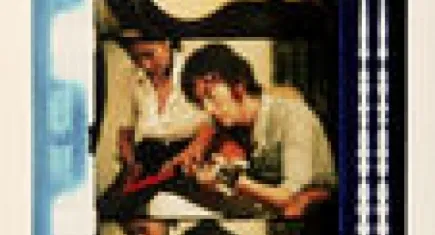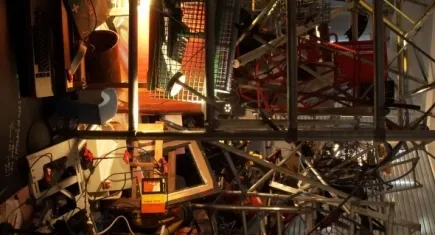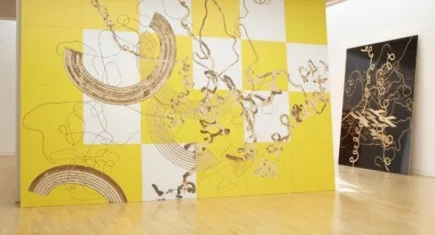Mead Gallery Exhibitions 2006
Jonas Mekas: A Brief Glimpse of Beauty
Mon 9 Oct – Sat 9 Dec 2006
“In this exhibition, as in my work in general, I am concerned with the discovery and celebration of small, insignificant, personal, moments of our life, my life, life of my family, my close friends; joys, celebrations, being together, small daily events, feelings, emotions, friendships. I consider that there is too much attention given today in the arts to dramatic, big events, themes, actions, exceptional situations, dramatizations, psychological and other perversions – all at the expense of what I consider is really important to the deeper, subtle, invisible events of our existence that make us what we are.”
Jonas Mekas
Jonas Mekas was born in 1922 in Semeiskiai, Lithuania. He currently lives and works in New York. In 1944, Jonas Mekas and his brother Adolfas were taken by the Nazis and imprisoned for eight months in a forced labour camp in Nazi Germany. After the war, in 1946-48, he studied philosophy at the University of Maintz and at the end of 1949 emigrated with his brother to the U.S., settling in Williamsburg, Brooklyn in New York. Two weeks after arrival, he borrowed the money to buy his first Bolex 16-mm camera and began to record moments of his life. He discovered avant-garde film at the venues such as Amos Vogel’s pioneering “Cinema 16” and began screening his own films in 1953. He has been one of the leading figures of American avant-garde filmmaking or the “ New American Cinema” as he dubbed it in the late 50s, playing various roles: In 1968 Mekas began writing his “Movie Journal” column for the “Village Voice”. In 1962 he co-founded the Film-Makers’ Cooperative (FMC) and the Filmmakers’ Cinematheque in 1964, which eventually grew into Anthology Film Archives, one of the world’s largest and most important repositories of avant-garde films.
Despite the autobiographical and personal nature of his work, Mekas was also an important chronicler of the New York art world in the 60’s and 70’s. His films contain invaluable documentation of this period’s avant-garde, featuring figures such as Andy Warhol, Jackie Kennedy, John Lennon and Yoko Ono, Allen Ginsberg, Lou Reed, and The Velvet Underground. Many of these films will receive a rare screening during the exhibition.
Jonas Mekas has exhibited extensively throughout the world, including Jeu de Paume, Paris, Metropolitan Museum of Photography, Tokyo and Documenta 11. ‘As I Was Moving Ahead, Occasionally I Saw Brief Glimpses of Beauty’ was one of the best received works at the Venice Biennale of 2005. This four-and-half hour film took a decade to complete and is randomly edited from films made since Jonas Mekas first got married in 1970. Documenting his life with his family and friends over a period of 30 years, it is an intensley intimate and moving film celebrating the precious things in life.
LIST OF WORKS
As I Was Moving Ahead, Occasionally I Saw Brief Glimpses of Beauty
2000, 16mm film, 288 min.
‘As I was Moving Ahead, Occasionally I Saw Brief Glimpses of Beauty’ is a record of subtle feelings, emotions, daily joys of people as recorded in the voices, faces and small everyday activities of people I have met, or lived with, or observed – something I have been recording for many years. This, as opposed to the spectacular, entertaining, sensational, dramatic activities which dominate much of the contemporary film making.
Now, all of this has to do with my understanding of what acts really affect the positive changes in man, society, humanity. I am interested in recording the subtle, almost invisible acts, experiences, feelings, as opposed to the tough, harsh, loud, violent activities and political actions, and especially, political systems of our time.
As a filmmaker, I am taking a stand for the politics that have been practiced by some of the artists of my generation who believe that more essential, positive contributions to the upholding and furthering of the best in humanity, have been made, say, by John Cage or Albert Camus, and not by great political figures of the 20th century.
The film is not conceived as a documentary film, however. It follows a tradition established by modern film poets. I am interested in intensifying the fleeting moments of reality by a personal way of filming and structuring my material. A lot of importance is being given to colour movement, rhythm and structure – all very important to the subject matter I am pursuing. I have spent many years developing and perfecting a way of catching the immediacy without interfering with it, without destroying it. I believe that some of the content that I am trying to record with my camera and share with others, can be caught only very indirectly through the intensity of personal involvement.
*Award Presentation to Andy Warhol *
1964, 16mm film, 12 min
The film documents Mekas giving Warhol the Film Culture Independent Film Award, set to the music of The Supremes. Jonas Mekas noted, “In 1964 Film Culture magazine chose Andy Warhol for its annual Independent Film award. The plan was to show some of Andy’s films and have Andy come on stage and hand him the award. Andy said, no, he didn’t want a public presentation. So I decided to hand him the award at The Factory, film the occasion, and show the film at the Award Presentation show at the New Yorker Theatre.” With: Gregory Battcock, Baby Jane Holzer, Kenneth King, Gerard Malanga, Ivy Nicholson, Naomi Levine, Gregory Markopoulos, Jonas Mekas, Andy Warhol, et al. Music: The Supremes.
Zefiro Torna or Scenes from the Life of George Maciunas
1992, 16mm film, 34 min.
“Includes footage I took of George in 1952 at his parents’ house, with his father, mother and sister Nijole, fragments of Fluxus performancers, picnics with friends (Almus, Warhol, Lennon, Yoko Ono, etc.), George’s wedding and footage I took of him in Boston Hospital three days before his death. The soundtrack includes Monteverdi, and myself reading from my diaries written during the last ten months of George’s life.”
Scenes from the Life of Andy Warhol
1990, 16 mm film, 35 min.
Music by the Velvet Underground recorded in 1966. Opening segment taped at the Dom at the public performance with Nico. End section: mass for Andy Warhol at St. Patrick’s Cathedral. The film is made up of my family diaries relating to Andy Warhol from the years 1965-1982. The locations are New York and Montauk (The Factory, House of George Maciunas, Village Gate, Psychiatrist’s Convention, home of Stephen Shore, The Warhol Estate, Montauk, etc.). The “cast” includes: Lou Reed, Nico, Eddie Sedgwick, Gerard Malanga, Andy Warhol, Allen Ginsberg, Ed Sanders, Barbara Rubin, Tuli Kupferberg, Peter Orlovsky, John Lennon, Yoko Ono, George Maciunas, Vincent Friemont, Henry Geldzahler, Paul Morrissey, Karen Lerner, Jay Lerner, Peter Beard, John Kennedy Jr., Lee Radziwill, Tina Radziwill, Anthony Radziwill, D’Alessandro, Caroline Kennedy, Mick Jagger, Jade Jagger and many others.
Tomoko Takahashi: Crash Course
A Mead Gallery Exhibition
Thu 11 May – Sat 17 Jun 2006
For her exhibition at Mead, Takahashi excavated the systems and organisational structures of the University of Warwick, meeting people from throughout the University, exploring the functions of the different departments and communities and the research and social interests of her collaborators.
Alongside this research, she identified and invited donations of cast-off, lost, useless material. Blackboards, posters, bags of recycled material, hundreds of pairs of spectacles, old computers, old furniture, bags of mushroom compost, a banjo … thousands of objects were delivered to the Mead Gallery and painstakingly arranged by the artist. Her installation took the debris of the University and turned it into an extraordinary landscape.
At the end of the exhibition, people queued from early in the morning to be first in line to enter the galleries and take whatever they wanted.
DJ Simpson
A Mead Gallery Exhibition
Wed 18 Jan – Sat 11 Mar 2006
DJ Simpson has been described as ‘a painter who doesn’t paint’, and refers to his own work as ‘drawing with electricity’. He is renowned for his large scale paintings which humorously reference grand works from the Abstract Expressionist canon, and the influence of painters such as Jackson Pollock and Willem de Kooning resonate playfully throughout his work.
Simpson works with laminated panels which are either pre-painted or have a bonded surface such as formica. His ‘brush’ is an electric routing tool, commonly used for the fine finishing of carpentry. He employs this tool to perform a fluid, abstract gesture, gouging into the colourful plywood or MDF panels to reveal the hidden textures underneath.
The end results are beautifully vibrant and energetic artworks which sit somewhere between drawing, painting, sculpture and installation. Their sheer scale and technique parodies and expands the history and language of modern abstract painting.
This exhibition is DJ Simpson’s first major museum show since ‘New Labour’ at the Saatchi Gallery in 2001. It presents significant works from collections and galleries in Europe and presents an important survey of Simpson’s development into the mature phase of his career.
The issues around drawing, painting and abstraction with which Simpson engages are expanded in a discrete exhibition of some of the most important works from the University’s own collection. These include major early paintings by Patrick Heron, Gene Davies and Jack Bush as well as works relating to recent acquisitions of major installations by David Batchelor, Ian Davenport and Liam Gillick.
The exhibition is accompanied by a beautiful illustrated book with essays by David Burrows and Simon O’Sullivan.



